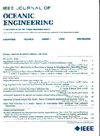Free Surface Elevation Estimator as a Sensor for Wave-Powered Data Buoys
IF 5.3
2区 工程技术
Q1 ENGINEERING, CIVIL
引用次数: 0
Abstract
There is a common perception when monitoring ocean waves, that data buoys, measuring parameters, such as significant wave height and dominant period, must have the characteristics of true wave followers, where the movement of the device is assumed to follow the free surface of the ocean. This presents an obstacle to using wave energy to power data buoys, as wave energy converters necessarily interact with passing waves to harness their energy. This study proposes a Kalman filter-based unknown input estimator to be used as a soft sensor to process readings from an existing motion sensor mounted a data buoy, taking into account the effects of an internal moonpool acting as an oscillating water column (OWC), including tests with an orifice plate to simulate a turbine power take-off (PTO). The estimator described in this article is tested against wave tank data in both regular and irregular waves, for a fully sealed moonpool, acting as a linear system. This article also describes how the Kalman filter can be extended to handle the nonlinearities introduced by fitting an orifice plate simulating an OWC turbine PTO, and tests this against regular wave data. The proposed sensor is found to accurately return values for significant wave height and zero-crossing period, as well as time series estimates of the free surface elevation, at 0.1 s time steps, for both linear and nonlinear system representations.作为波浪动力数据浮标传感器的自由表面高程估计器
在监测海浪时,有一种普遍的看法,即数据浮标,测量参数,如有效波高和主导周期,必须具有真正的波浪跟踪器的特征,即假设设备的运动跟随海洋的自由表面。这给利用波浪能为数据浮标提供动力提出了一个障碍,因为波浪能转换器必须与经过的波浪相互作用才能利用它们的能量。本研究提出了一种基于卡尔曼滤波的未知输入估计器,将其用作软传感器来处理安装在数据浮标上的现有运动传感器的读数,同时考虑到内部月池作为振荡水柱(OWC)的影响,包括用孔板模拟涡轮动力输出(PTO)的测试。本文中描述的估计器在一个完全密封的月池中作为线性系统,在规则波和不规则波中对波槽数据进行了测试。本文还介绍了如何将卡尔曼滤波器扩展到处理通过拟合模拟OWC涡轮PTO的孔板所引入的非线性,并对规则波数据进行了测试。所提出的传感器可以准确地返回有效波高和过零周期的值,以及0.1 s时间步长的自由表面高程的时间序列估计,用于线性和非线性系统表示。
本文章由计算机程序翻译,如有差异,请以英文原文为准。
求助全文
约1分钟内获得全文
求助全文
来源期刊

IEEE Journal of Oceanic Engineering
工程技术-工程:大洋
CiteScore
9.60
自引率
12.20%
发文量
86
审稿时长
12 months
期刊介绍:
The IEEE Journal of Oceanic Engineering (ISSN 0364-9059) is the online-only quarterly publication of the IEEE Oceanic Engineering Society (IEEE OES). The scope of the Journal is the field of interest of the IEEE OES, which encompasses all aspects of science, engineering, and technology that address research, development, and operations pertaining to all bodies of water. This includes the creation of new capabilities and technologies from concept design through prototypes, testing, and operational systems to sense, explore, understand, develop, use, and responsibly manage natural resources.
 求助内容:
求助内容: 应助结果提醒方式:
应助结果提醒方式:


